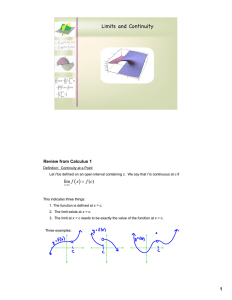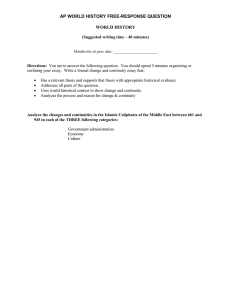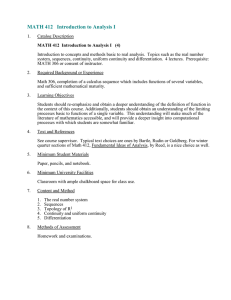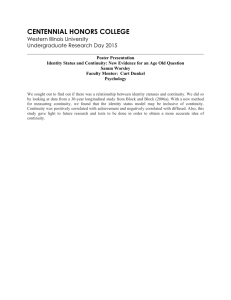American History Exam Questions: 1491-1848
advertisement
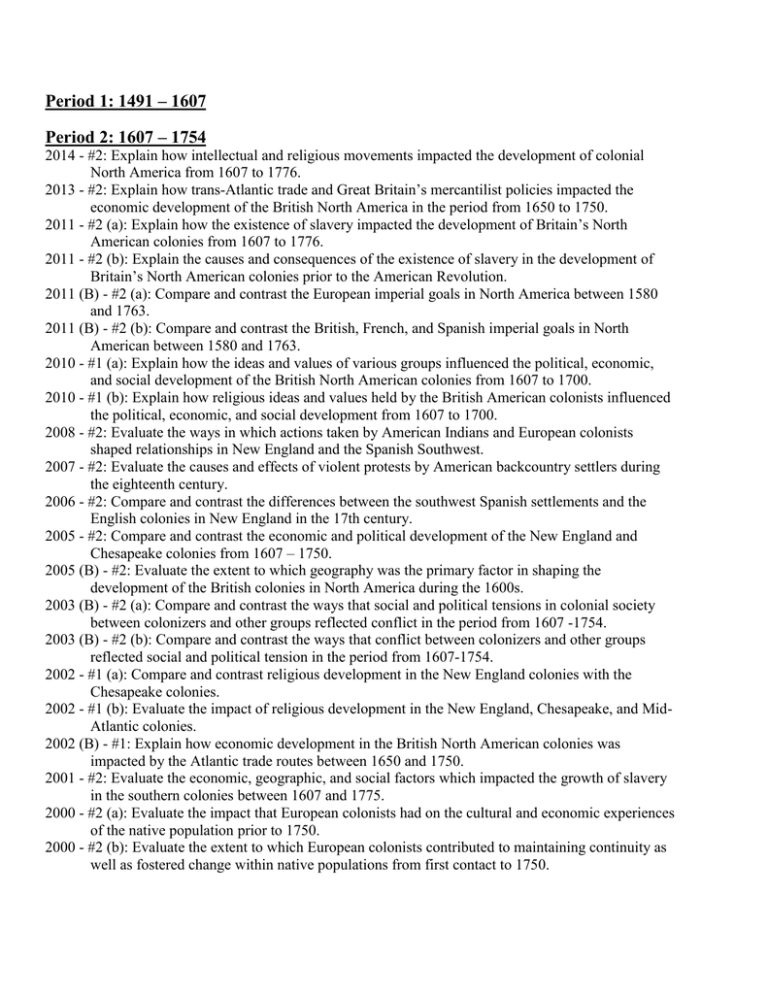
Period 1: 1491 – 1607 Period 2: 1607 – 1754 2014 - #2: Explain how intellectual and religious movements impacted the development of colonial North America from 1607 to 1776. 2013 - #2: Explain how trans-Atlantic trade and Great Britain’s mercantilist policies impacted the economic development of the British North America in the period from 1650 to 1750. 2011 - #2 (a): Explain how the existence of slavery impacted the development of Britain’s North American colonies from 1607 to 1776. 2011 - #2 (b): Explain the causes and consequences of the existence of slavery in the development of Britain’s North American colonies prior to the American Revolution. 2011 (B) - #2 (a): Compare and contrast the European imperial goals in North America between 1580 and 1763. 2011 (B) - #2 (b): Compare and contrast the British, French, and Spanish imperial goals in North American between 1580 and 1763. 2010 - #1 (a): Explain how the ideas and values of various groups influenced the political, economic, and social development of the British North American colonies from 1607 to 1700. 2010 - #1 (b): Explain how religious ideas and values held by the British American colonists influenced the political, economic, and social development from 1607 to 1700. 2008 - #2: Evaluate the ways in which actions taken by American Indians and European colonists shaped relationships in New England and the Spanish Southwest. 2007 - #2: Evaluate the causes and effects of violent protests by American backcountry settlers during the eighteenth century. 2006 - #2: Compare and contrast the differences between the southwest Spanish settlements and the English colonies in New England in the 17th century. 2005 - #2: Compare and contrast the economic and political development of the New England and Chesapeake colonies from 1607 – 1750. 2005 (B) - #2: Evaluate the extent to which geography was the primary factor in shaping the development of the British colonies in North America during the 1600s. 2003 (B) - #2 (a): Compare and contrast the ways that social and political tensions in colonial society between colonizers and other groups reflected conflict in the period from 1607 -1754. 2003 (B) - #2 (b): Compare and contrast the ways that conflict between colonizers and other groups reflected social and political tension in the period from 1607-1754. 2002 - #1 (a): Compare and contrast religious development in the New England colonies with the Chesapeake colonies. 2002 - #1 (b): Evaluate the impact of religious development in the New England, Chesapeake, and MidAtlantic colonies. 2002 (B) - #1: Explain how economic development in the British North American colonies was impacted by the Atlantic trade routes between 1650 and 1750. 2001 - #2: Evaluate the economic, geographic, and social factors which impacted the growth of slavery in the southern colonies between 1607 and 1775. 2000 - #2 (a): Evaluate the impact that European colonists had on the cultural and economic experiences of the native population prior to 1750. 2000 - #2 (b): Evaluate the extent to which European colonists contributed to maintaining continuity as well as fostered change within native populations from first contact to 1750. 1998 - #2 (a): Evaluate the extent to which religious toleration in the British North American colonies maintained continuity as well as fostered changed from 1607-1700. 1998 - #2 (b): Evaluate the extent to which religious makeup of the British North American colonies maintained continuity as well as changed over the period 1607-1700. 1993 - #1: Compare and contrast the development of society within different colonial regions from 1607 to 1700. Period 3: 1754 – 1800 2012 - #2 (a): Explain how the French and Indian War impacted the relationship between Great Britain and the British colonies from 1754 to 1776. 2012 - #2 (b): Evaluate the extent to which the French and Indian War was a turning point in American History. 2011 (B) - #3 (a): Explain the major political, economic, and diplomatic causes and consequences for the call for the ratification of the U.S. Constitution and its adoption in 1787. 2011 (B) - #3 (b): Evaluate the extent to which the ratification of the U.S. Constitution (1787) was a political and economic turning point in the history of the United States. 2010 - #2 (a): Explain the political, diplomatic, and military causes which led to the victory in the American Revolution. 2010 - #2 (b): Explain the political and economic causes which led to the independence movement from the end of the Seven Years War until the end of the American Revolution. 2009 - #2 (a): Evaluate the extent that the Seven Years War (1763) was a turning point in colonial responses to British Imperial policy through 1776 2009 - #2 (b): Explain the extent to which British imperial policies after the Seven Years War (1763) through 1776 intensified colonials’ resistance to British rule. 2009 - #3 (c): Evaluate how British imperial policies changed the relationship between the colonies and the British between the years 1763-1776. 2009 - #2 (c): Explain the impact of British imperial policies after the Seven Years War (1763) through 1776 on colonials’ resistance to British rule. 2009 (B) - #2: Evaluate the extent to which revolutionary ideals and experiences shaped the creation of a new government both during and after the American Revolution. 2008 (B) - #2 (a): Compare and contrast the reasons for support and opposition to the ratification of the Constitution. 2008 (B) - #2 (b): Compare and contrast the political and economic ideas of the Federalist and Antifederalist. 2007 (B) - #2: Evaluate the extent to which the French and Indian War fostered change or maintained continuity in the relationship between the North American colonies and Great Britain in the period between 1763 and 1775. 2006- #2: Evaluate the extent to which the ratification of the US Constitution was a turning point for the traditional American political elite. 2005 - #1: Evaluate the extent to which the American Revolution changed the political, economic, and social aspects of American society from 1775 to 1800. 2005 (B) - #3: Compare and contrast the Articles of Confederation and the U.S. Constitution. 2004 - #1 (a): Evaluate the way the Seven Years War contributed to maintaining continuity as well as fostering change in relations between Britain and its American colonies. 2004 - #1 (b): Evaluate the extent to which the Seven Years War altered relations between Britain and its American colonies. 2004 - #2: Evaluate the impact of the American Revolution on both slavery and the status of women. 2003 - #2: Evaluate the major causes which lead the country to abandon the Articles of Confederation and ratify the U.S. Constitution. 2002 - #2: Evaluate the political consequences, which helped establish a stable government, as a result of adoption of the U.S. Constitution. 1999 - #1: Evaluate the extent to which a sense of identity and unity contributed to maintaining continuity as well as fostered change within the American colonies from the years 1607 to 1776. 1997 - #2: Evaluate the extent to which the American Revolution represented a turning point in democratic ideas and republican forms of government. 1996 - #2: Explain the political and economic causes which led to the ratification of the U.S. Constitution. 1995 - #1 (a): Explain the ways in which Britain’s policies prior to the beginning of the Seven Years War (1754) influenced the political, economic, and social development of the American colonies. 1995 - #1 (b): Evaluate the causes of the British government which led to the development of the independence movement prior to 1776. 1994 - #3 (a): Compare and contrast the extent to which domestic and foreign affairs shaped American politics in the 1790s. 1994 - #3 (b): Explain the causes and consequences of domestic and foreign affairs in American politics in the 1790s. 1992 - #1: Explain the major causes that prompted the Americans to rebel in 1776. Period 4: 1800 – 1848 2014 - #3 (a): Compare and contrast views of the role of the federal government and westward expansion between different regional political leaders 1800 to 1848. 2014 - #3 (b): Compare and contrast views of the role of the federal government and westward expansion between different political parties from 1800 to 1848. 2013 - #1 (a): Evaluate the causes and consequences of the growing opposition to slavery in the United States from 1776 to 1856. 2013 - #1 (b): Evaluate the extent to which the opposition to slavery contributed to maintaining continuity as well as fostered change in the United States from 1776 to 1856. 2013 - #3: Evaluate the extent to which American foreign policy contributed to maintaining continuity as well as fostered change with regard to United States involvement in world affairs from 1796 to 1823. 2012 - #3: Evaluate the extent to which western expansion contributed to maintaining continuity as well as fostered change with regard to growing sectional tensions between the North and South in United States from 1800 to 1850. 2011 - #3: Evaluate the extent to which political parties contributed to maintaining continuity as well as fostered change with regard to national unity in the United States from 1790 to 1840. 2009 (B) - #3 Evaluate the extent to which politics, economics, and religion impacted tensions between Roman Catholics and native-born Protestants in the United States from the 1830s through the 1850s 2008 - #3 (a): Compare and contrast the political and economic characteristics of the Northeast and the South from 1800 to 1860. 2008 - #3 (b): Evaluate the impact of the market revolution on the various regions of the United States from 1815 to 1860. 2008 - #3 (c): To what extent did the economies of the Northeast, Midwest, and South reflect consistency or significant change during the time period 1815 to 1860. 2008 (B) - #3: Evaluate the extent to which Africa Americans developed a distinct culture in slavery. 2007 - #3: Evaluate the causes and consequences of religious and intellectual movements on American reform during the mid-nineteenth century. 2007 (B) - #3 (a): Compare and contrast the experiences of various European immigrant groups during the period 1830 to 1860. 2007 (B) - #3 (b): Evaluate the effect of various European immigrant groups on the development of a distinct American identity in the period 1830 to 1860. 2005 (B) - #1: Evaluate the extent to which sectional conflict from 1820 to 1860 contributed to maintaining continuity as well as fostering change in political ideals and attempts to compromise. 2004 (B) - #2 (a): To what extent did transition from the Federalist Party to the Democratic-Republics transform the debate over federal power? 2004 (B) - #2 (b): To what extent did transition from the Federalist party to the Democratic-Republics transform economics, foreign policy, and politics? 2004 (B) - #3: Evaluate the extent to which the role of women maintained continuity as well as fostered change in economic, political, and social arenas between 1790 and 1860? 2003 - #3: Evaluate ways developments in transportation brought about economic and social change in the United States in the period 1800 to 1848. 2003 (B) - #3: Evaluate the causes and consequences of opposition to the growing power of the national government from 1790-1840. 2002 (B) - #2 (a): Evaluate the main causes that lead to nationalism and sectionalism prior to the Civil War. 2002 (B) - #2 (b): “After the War of 1812 an Era of Good Feelings emerged within American society.” Support, modify, or refute this statement. 2001- #3: “Andrew Jackson’s presidency was a Turning Point for rise of democracy in American politics.” Support, modify, or refute this statement. 2000 - #3 (a): Explain how the abolitionist movement impacted politics in the period from 1820-1860. 2000 - #3 (b): Evaluate the impact of the acquisition of new territories in the West had on American politics from 1820-1860. 2000 - #3 (c): Evaluate the causes which led to the development of the abolitionist movement prior to the Civil War. 2000 - #3 (d): Explain how the acquisition of new territories in the West contributed to increased political tension and ideological conflict over slavery. 1999 - #2: Explain the extent to which social and political issues contributed to the reemergence of a two party system in the period 1820 to 1840. 1998 - #1: Compare and contrast views expressed by Federalists and Democratic-Republicans with regard to the power of the federal government and its relationship with the states. 1997 - #3: Evaluate the extent to which national unity was impacted by territorial expansion between 1800-1848. 1996 - #3 (a): Evaluate the impact that political, economic, and social factors had on the development of American democracy between 1820 and 1840. 1996 - #3 (b): Evaluate the extent to which American democracy contributed to maintaining continuity as well as fostered change from 1820 to 1840. 1995 - #2: Evaluate the legal, religious, and economic factors which led to the defense of the institution of slavery. 1994 - #2 (a): Explain how religious movements influenced the development of American society from the late seventeenth century to the early nineteenth century. 1994 - #2 (b): Evaluate the extent to which religious movements contributed to both maintaining continuity and fostering change within American society from the late seventeenth century to the early nineteenth century. 1993 - #2 (a): Compare and contrast the foreign policy goals and strategies of Presidents in the period 1800-1848. 1993 - #2 (b): Evaluate the extent to which US Presidential foreign policy goals contributed to maintaining continuity as well as fostered change from 1800-1848. 1993 - #3: Compare and contrast different reform movements in bringing about political and economic equality in the early American republic. Period 5: 1844 – 1877 2011 (B) - #1 (a): Evaluate the extent to which increased democracy contributed to maintaining continuity as well as fostered change in the first half of the United States. 2011 (B) - #1 (b): Explain the major causes and consequences for the increased democracy in the first half of the United States. 2010 - #3 (a): Explain the ways in which controversy over the extension of slavery into western territories contributed to the causes of the Civil War from 1800 to 1860. 2010 - #3 (b): Explain the ways in which the growth of slavery contributed to the coming of the Civil War from 1800 to 1860. 2009 - #1 (a): Evaluate the extent to which the expansion of slavery contributed to maintaining continuity as well as fostered change in the lives of African-Americans prior to the Civil War. 2009 - #1 (b): Evaluate major changes and continuities in the institution of slavery in the South during the 18th and 19th centuries. 2009 - #3 (a): Explain the social, political, and economic forces that led to the emergence of sectional political parties before the Civil War. 2009 - #3 (b): “The emergence of the Republican Party signaled the end of the antebellum period.” Support, modify, or refute. 2009 - #1 (a): Evaluate the changing role of African-Americans within American society from 1861 to 1870. 2009 - #1 (b): “The Civil War was a turning point in the lives of African-Americans.” Agree, disagree, or modify this statement. 2006 - #1: Evaluate the extent to which womanhood changed between the American Revolution (1770) and the outbreak of the Civil War. Be sure to consider the issues of race and class. 2006 - #3: Explain the causes which led to a shift in political power as a result of the impact of the Civil War on the federal government from 1861 to 1877. 2006 (B) - #3 (a): Evaluate the extent to which industrial development from 1800 to 1860 was a factor in the relationship between the northern and southern states. 2006 (B) - #3 (b): Explain how industrial development from 1800 to 1860 impacted the relationship between the northern and southern states. 2005 - #3: Evaluate the major causes and consequences of the Mexican War on American society 2004 - #3 (a): Evaluate the impact of political compromise on sectional tensions in the period 1820 to 1861. 2004 - #3 (b): Evaluate the extent to which political compromise contributed to maintaining continuity as well as fostering change on sectional tensions in the period 1820 to 1861. 2003 - #4 (a): Evaluate the impact of the civil war, politically and economically, in different regions of the United States. 2003 - #4 (b): Compare and contrast the political and economic influences of the Civil War on two different regions of the country. 1997 - #4: Evaluate the economic, social and cultural consequences of the Civil War during the period of 1865-1880. 1996 - #1: Explain the extent to which constitutional and social developments contributed to maintaining continuity as well as fostering change during the Civil War to the end of Reconstruction. Period 6: 1865 – 1898 2014 - #4 (a): Evaluate the political, economic, and social reactions of Americans to the end of Reconstruction (1877). 2014 - #4 (b): Evaluate the political, economic, and social reactions of African Americans to the end of Reconstruction (1877). 2014 - #4 (c): Evaluate the extent to which the goals of Reconstruction (1865 – 1877) regarding African Americans were achieved by 1900. Be sure to address both continuities as well as changes during this time period. 2014 - #4 (d): Evaluate the extent to which the goals of Reconstruction (1865 – 1877) contributed to maintaining continuity as well as fostered change before 1900. 2014 - #4 (e): Evaluate the extent to which the end of Reconstruction (1877) was a turning point in American History. 2013 - #4 (a): Explain how technological innovations impacted the lives of urban and rural workers during 1865 to 1920. 2013 - #4 (b): Evaluate the extent to which technological innovations contributed to maintaining continuity as well as fostered change in the lives of urban and rural workers in United States from 1865 to 1920. 2012 - #1: Explain the major political and economic causes and consequences for the growth of big business in American society from 1870 to 1900. 2010 - #4 (a): Explain the continuities and changes in the roles that women played in the Progressive Era political and social reforms from the 1880s through the 1920s. 2010 - #4 (b): Explain the impact women had on the political and social reforms of the Progressive Era from the 1880s through the 1920s. 2009 - #4 (a): Compare and contrast labor union strategies between the 1870s and 1920s. Be sure to address their strategies for advancing the interests of workers and their success in achieving those goals. 2009 - #4 (b): Compare and contrast the strategies of unions in advancing the goals of workers between the 1870s and 1920s. 2009 - #4 (c): Compare and contrast the success of unions between the 1870s and 1920s in achieving their objectives for workers. 2009 (B) - #4 (a): Explain the origins of third parties and their effects on United States politics and national policies after 1877. 2009 (B) - #4 (b): Explain the origins of The Populist Party (1892) and its effects on United States politics and national policies. 2008 - #4 (a): Evaluate the extent to which politics and race relations contributed to maintaining continuity as well as fostered change from the end of Reconstruction till WWI in the South. 2008 - #4 (b): Evaluate the extent to which the New South envisioned by some southern leaders materialized between the end of Reconstruction and the First World War. 2008 - #1 (a): Evaluate the extent to which tensions surrounding the issue of immigration led to a government response from 1880 to 1925. 2008 - #1 (b): Evaluate the causes and consequences of immigration tensions from 1880 to 1925. 2007 - #1 (a): Evaluate the extent to which advances in agriculture contributed to maintaining continuity as well as fostered change within American society during the period from 1865 to 1900. 2007 - #1 (b): Evaluate the causes which led to the agricultural changes within American society during the period from 1865 to 1900. 2007 (B) - #4: Compare and contrast the responses of industrial leaders and progressive era reformers to the economic and social problems created by industrialization during the late nineteenth and early twentieth centuries. 2006 (B) - #4: Evaluate the extent to which the American West was a land of opportunity for various groups from 1865 to 1890. 2005 (B) - #4: Evaluate the extent to which conditions of industrial workers and urban life contributed to maintaining continuity as well as fostering change in American society from 1890 to 1920. 2004 (B) - #4: Explain the major causes of the population shift from a rural to an urban environment in the United States between 1875 and 1925. 2003 (B) - #4: Evaluate the ways that farmers and industrial workers responded to industrialization in the Gilded Age (1865 to 1900). 2001- #4: Evaluate the extent to which transportation developments spark economic growth contributed to maintaining continuity as well as fostered change in American society from 1860 to 1900. 2000 - #1 (a): Evaluate the extent to which organized labor contributed to maintaining continuity as well as fostered change in American society from 1875 to 1900. 2000 - #1 (b): Compare and contrast the goals and strategies of organized labor unions from 1875 to 1900. 1999 - #3: Explain the extent to which the lives of the American Indians were impacted by western settlement from 1865 – 1898. 1998 - #3 (a): Evaluate the impact of technological change, immigration, and unionization on the American industrial worker between 1865 and 1900. 1998 - #3 (b): Evaluate the impact of technological change, immigration, and government actions on the American industrial worker between 1865 and 1900. 1995 - #3: Explain the major causes and consequences of the Populist movement in the late nineteenth century. 1994 - #4: Compare and contrast American activists and economic leaders’ views/visions towards wealth in the late nineteenth century. 1993 - #4: Evaluate the ways in which state and federal legislation and judicial decisions, including those of the Supreme Court, affected the efforts of African Americans and farmers to improve their position in society between 1880 and 1920. 1992 - #2: Compare and Contrast the political and economic debates over American expansionism in 1840s with those in the 1890s. 1992 - #3 (a): Evaluate the extent to which the political, economic and social reform goals of Reconstruction contributed to continuity as well as fostered change in the United States between 1864 and 1900. 1992 - #3 (b): Evaluate the extent to which the end of Reconstruction was a turning point in American History. 1992 - #6: Evaluate the extent to which the natural environment shaped the development of the West and the lives of those who lived and settled there from the 1840’s through the 1890’s. Period 7: 1890 – 1945 2012 - #4 (a): Explain the major causes and consequences for the cultural conflicts of the 1920’s in the United States. 2012 - #4 (b): Evaluate the extent to which the 1920’s were a cultural turning point in American History. 2011 - #4: Compare and contrast reactions of Americans to immigration in the 1840s-1850s with immigration in the 1910s-1920s. 2009 - #5 (a): Compare and contrast the home front experiences between minority Americans during the Second World War. 2009 - #5 (b): Compare and contrast the home front experiences of women and minorities during the Second World War. 2009- #5 (c): Evaluate major changes and continuities in the social and economic experiences of women and minorities during World War II. 2008 - #5: Explain the causes and consequences of major shifts in political party loyalties that were evident in presidential elections between 1920 and 1948. 2008 (B) - #4: Evaluate the extent to which the Spanish-American War was a turning point in foreign policy in the United States. 2007 - #4: Evaluate the extent to which the role of the federal government contributed to maintaining continuity as well as fostered change within American society through the first half of the twentieth century. 2007 (B) - #3 (c): Evaluate the extent to which the mainstream American response to immigration reflected continuity as well as change between earlier immigration in the period 1830 to 1860 and later immigration in the period 1880 to 1930. 2007 (B) - #5 (a): Evaluate the effects of the First World War on the Home Front. 2007 (B) - #5 (alternative): Evaluate the effects of the Second World War on the Home Front. 2006 - #4: Evaluate the reasons for the loss of momentum of the Progressive Movement during 1920s. 2006 (B) - #1 (a): Evaluate the extent to which increased suspicion and tension between the US and the Soviet Union contributed to maintaining continuity as well as fostering change in US society from 1941 to 1949. 2006 (B) - #1 (b): Evaluate the causes and consequences of increased suspicion and tension between the US and the USSR from 1941 to 1949. 2006 (B) - #1 (c): Evaluate the underlying forces and specific events that contributed to the increased suspicion and tension between the US and the USSR from 1941 to 1949. 2006 (B) - #5: Evaluate the extent to which new technologies impacted American culture in the 1920's. 2004 - #4: Compare and contrast the programs and the policies of the Progressive reformers with those of the New Deal reformers. 2004 (B) - #1 (a): Evaluate the extent to which United States foreign policy maintained continuity as well as fostered change between 1920 and 1941? 2004 (B) - #1 (b): Explain the major causes of change in United States foreign policy from 1920 to 1941? 2003 - #1 (a): Evaluate the extent to which FDR’s administration maintained continuity as well as fostered change in the role of the federal government during the Great Depression. 2003 - #1 (b): Evaluate the short-term and long-term effects of the responses of FDR’s Administration to the Great Depression. 2003 (B) - #1: Evaluate the extent to which Progressive reformers and the federal government maintained continuity as well as fostered change during the period 1900-1920. 2002 - #3: “Reform movement in the U.S. sought to expand democratic ideals.” Support, modify, or refute this statement. 2002 - #4 (a): Compare and contrast the United States foreign policy in the period after World War I (1919-1928) with the period after World War II (1945-1950). 2002 - #4 (b): Evaluate the extent to which the United States foreign policy contributed to continuity as well as fostered change in the first half of the 20th Century. 2001 - #5: Evaluate the causes and consequences of nativism in American society from 1900-1930. 2000 - #4 (a): Evaluate the extent to which the United States entry into World War I was a turning point in America’s foreign policy. 2000 - #4 (b): Evaluate the extent to which the American experience of World War I impacted foreign policy ideologies from 1918-1945. 1999 - #4 (a): “The 1920s represent a significant American cultural expression.” Support, modify, or refute this statement. 1999 - #4 (b): Evaluate the extent to which the 1920s were a turning point of cultural and economic change? 1998 - #4 (a): Evaluate the causes for the isolationist policy of the United States in the 1920s and 1930s. 1998 - #4 (b): Evaluate the extent to which United States foreign policy changed as well as maintained continuity over the period 1917-1932. 1998 - #4 (c): Compare and contrast the foreign policy beliefs of isolationists and interventionists over the period 1917-1932. 1997 - #1 (a): Considering the assumptions about the nature of American women, to what extent did Progressive reformers affect the position of American women during the period 1890-1925? 1997 - #1 (b): Evaluate the extent to which economic and political developments as well as the assumptions about the nature of women contributed to maintaining continuity as well as fostering change in the position of American women from 1890-1925. 1997 - #4: Evaluate the extent to which the Great Depression contributed to maintaining continuity as well as fostering change in American society in the 1930s. 1995 - #4: Evaluate the extent to which improved mass communication, American interests, and America’s role in the world caused American entry into World War I. 1994 - #1 (a): Evaluate the extent to which late nineteenth-century and early twentieth-century United States expansionism contributed to both maintaining continuity and fostering change in America’s role in the world prior to World War One. 1994 - #1 (b): Evaluate the extent to which turn of the century United States expansionism marked a turning point in foreign policy in the United States. 1992 - #5: Evaluate the extent to which New Deal reform measures impacted the economy and society. Period 8: 1945 – 1980 2014 - #1: Evaluate the extent to which US foreign policy goals contributed to maintaining continuity as well as fostered change from the end of WWI (1918) to the end of the Korean War (1953). 2014 - #5 (a): Evaluate the extent to which policy goals of the conservatives in the 1950's impacted social, economic, and foreign policy by the 1980’s. 2014 - #5 (c): Evaluate the extent to which the goals of conservatives contributed to maintaining continuity as well as fostered change from the 1950s through the 1980s. 2014 - #5 (b): Compare and contrast domestic and foreign policy goals of conservatives in the 1950’s with conservatives in the 1980’s. 2013 - #5 (a): Explain the major causes and consequences of protest among different members of the counter culture from 1945 to 1975. 2013 - #5 (b): Evaluate the extent to which different members of the counter culture contributed to maintaining continuity as well as fostered change in the United States from 1945 to 1975. 2012 - #5 (a): Compare and contrast the different foreign policy approaches of containment and isolationism during the Cold War. 2012 - #5 (b): Evaluate the extent to which American foreign policy goals contributed to maintaining continuity as well as fostered change during the Cold War. 2011 - #1 (a): Explain the causes and consequences of international and domestic challenges the United States faced between 1968 and 1974. 2011 - #1 (b): Evaluate the extent to which international and domestic challenges contributed to maintaining continuity as well as fostered change in the United States from 1960 to 1980. 2011 - #5: Compare and contrast goals and strategies of African American leaders in the 1890s-1920s with the goals and strategies of African American leaders in the 1950s-1960s. 2011 (B) - #4: Compare and contrast 20th century United States foreign policy goals prior to WWII with those after WWII. 2011 (B) - #5: Compare and contrast the women’s rights movement of the 1840s-1860s with the women’s rights movement of the 1960s-1980s. 2010 - #5: Explain the causes and consequences of the population movements in United States history during the period 1945 to 1985. 2009 (B) - #5 (a): Evaluate the extent to which Americans’ confidence in their nation’s economic power and international influence diminished due to events and trends of the 1970’s. 2009 (B) - #5 (b): “During the 1970’s, Americans’ political and economic confidence in their nation’s global influence substantially diminished.” Support, modify, or refute this statement. 2008 - #1 (a): Evaluate the extent to which the Vietnam War was the turning point in the economic and political tension in the United States. 2008 - #1 (b): “The Vietnam War was a turning point in the political and economic division in the United States.” Support, modify, or refute this statement. 2008 - #1 (c): Evaluate the extent to which the Vietnam War impacted social and economic tensions in the United States from 1964 to 1975. 2008 (B) - #5: Compare and contrast technology and attitudes of Americans in the 1920s and 1950s. 2007 (B) - #1: Evaluate the extent to which the policies of President Lyndon B. Johnson were caused by the social, economic, and political problems of the United States. 2004 - #5: Evaluate the impact of the United States policy of Containment in Asia and Europe during the period 1945 to 1975. 2004 (B) - #5: To what extent, was the period of 1960 to 1975 a time of great progress for political and social equality. 2003 - #5: Compare and contrast cultural and economic characteristics in United States society in the 1920s with the 1950s. 2003 (B) - #5 (a): Evaluate the political and technological forces that caused the change in the role of the American presidency from 1960-1975. 2003 (B) - #5 (b): Evaluate the extent to which the role of the American presidency changed or remained the same from 1960-1975. 2002 - #5: To what extent did the Civil Rights movement of the 1950s and 1960s constitute a turning point for African-Americans. 2001 - 1: Evaluate the major causes of the Cold War fears of the American people following World War II. 2000 - #5: Evaluate the extent to which the 1960s counterculture constituted a societal and political turning point. 2000 - #5: Evaluate the political, economic, and social impact that the 1960s counterculture had on American society. 1999 - #5 (a): Compare and contrast the successes and failures of the United States policy of containment from 1945 – 1980. 1999 - #5 (b): Evaluate the extent to which policies to contain communism contributed to maintaining continuity as well as fostered change in American foreign policy from 1945 – 1980. 1999 - #5 (c): To what extent were the policies of containment successful in addressing the foreign policy concerns of the US from 1945 to 1980. 1998 - #5: Evaluate the extent to which the 1960s counterculture was a turning point for the United States in regards to domestic and international issues. 1997 - #5: Explain how United States political and cultural policies during the Cold War led to an increase in anti-Communist sentiment in the United States following WWII. 1996 - #5: Explain the foreign and domestic causes which led to American and Soviet tensions after World War II. 1995 - #5: Evaluate the extent to which the 1960s was a turning point in the civil rights movements in American society. 1994 - #5 (a): Evaluate the extent to which the 1950s was a decade/age of political, social, and cultural conformity. 1994 - #5 (b): “The 1950s were a decade of political, social, and cultural conformity.” Support, modify, or refute this statement. 1993 - #6: Evaluate the ways in which changing economic conditions and the rebirth of an organized women’s movement affected the status of women in American society since 1940. 1992 - #4: Compare and contrast the origins and goals of the New Deal and the Great Society. 1992 - #5: Evaluate the extent to which the United State’s global preeminence was challenged from 1945 to 1975. Period 9: 1980 – Present 2005 - #4: Compare and contrast the patterns of immigration and the American response to those immigrants in two of the following periods, 1820 to 1860, 1880 to 1924, and 1965 to 2000. 2005 (B) - #5 (a): Explain the ways that technological advances and war maintained continuity as well as fostered change in the lives of women in the United States during the twentieth century. 2005 (B) - #5 (b): Explain the effects of popular culture on the lives of women in the United States in the twentieth century. 2005 (B) - #5 (c): Explain the ways that popular culture maintained continuity as well as fostered change in the lives of women in the United States during the twentieth century.


